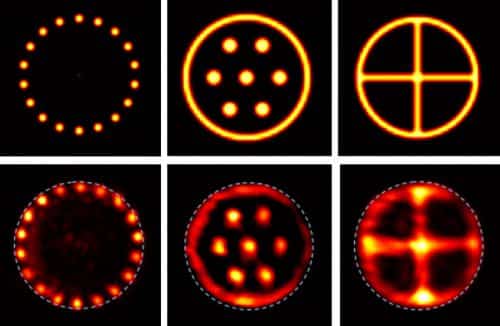Is it possible to decipher the structure of an object by "backward calculation" of the scattered radiation data after hitting it?

To examine and map the structure of small bodies (for example a virus or an intracellular organelle as well as a two-dimensional image), the scientists launch a beam of electromagnetic radiation towards the object being studied. The radiation hits the body being studied, and is scattered from it, in a way that is affected by its structure. The scientists measure the scattering data of the radiation, and if they had strong enough mathematical tools, they could "calculate backwards" the data of the scattering radiation, and obtain, as a result, the exact structure of the body being studied.
But unfortunately, such a calculation, "backwards", is what mathematicians call a "hard problem". That is, we have no efficient way to perform this calculation based on the measured data alone. In fact, the radiation intensity can be calculated. The difficulty stems from our inability to "calculate backwards" (reproduce) the phase or occurrence of the light. This fact gave the problem its name: "the phase reconstruction problem".
The scientists of the Weizmann Institute of Science, who wanted to deal with this problem, recently succeeded in building an optical system that is able to calculate the light scattering data very quickly, reproduce the phase of the radiation - and solve the structure of the object being studied. The scientists, Prof. Nir Dodzon and the post-doctoral researcher Dr. Chen Tardonsky, together with Prof. (Emeritus) Asher Prizm, the senior researcher Dr. Oren Raz, the research student Igor Gershenzon, the former research student, Dr. Ronan Shariki, and the researcher Post-doctoral (former) Dr. Vishwa Pal, from the Department of Physics of Complex Systems, built a laser resonator (a system in which the laser beam "passes back and forth" between two mirrors), one of whose mirrors is "programmed" so that it "knows" the intensity of the scattered radiation only. In the center of the resonator (at the "junction" where the laser beam passes back and forth between the two mirrors), they installed a "form cue", a kind of window in the approximate structure of the object being studied. Such a formal clue can be obtained, for example, using an ordinary microscope, which can provide a kind of "silhouette" of the object being studied, but not its exact structure.
The laser beam that passes between the two mirrors undergoes a kind of evolution: initially there are thousands of shapes that may fit the structure of the bone being studied, but with each pass of the laser, the number of unsuitable solutions decreases significantly, and the correct solution increases and 'takes over'"
The laser beam, which passes between the two mirrors, and repeatedly passes through the "form clue", undergoes a kind of evolution: initially there are thousands of shapes that may match the shape clue and the structure of the object being studied, but with each pass of the laser through the resonator, the number of unsuitable solutions decreases significantly, and increases and The correct solution "takes over". This way of optical selection is about a million times faster than a normal computerized process that is required to calculate and find the solution of the same problem.
The principle of optical selection in a laser resonator is used by the institute's scientists for an efficient and fast solution of additional computational problems, such as imaging through a scattering material (such as biological tissue), shaping light beams and simulations of complex magnetic materials. The "Yade" company, which promotes applications based on the inventions of the institute's scientists, has already registered a patent for the system, and soon a start-up company will be established that will develop industrial applications for solving difficult computational problems using lasers.
Optical calculation of the phase reconstruction of scattered light is Million times faster than normal calculation.

2 תגובות
You forgot to write Q
The laser beam, which passes between the two mirrors, and repeatedly passes through the "form clue", undergoes a kind of evolution: initially there are thousands of shapes that may match the shape clue and the structure of the object being studied, but with each pass of the laser through the resonator, the number of unsuitable solutions decreases significantly, and increases and The correct solution "takes over".
Or at least that
The laser beam that passes between the two mirrors undergoes a kind of evolution: initially there are thousands of shapes that may match the structure of the bone being studied, but with each pass of the laser, the number of unsuitable solutions decreases significantly, and the correct solution increases and 'takes over'
It's a shame that a schematic drawing of the device, or at least a photograph of it, was not added to the article. What an interesting article.